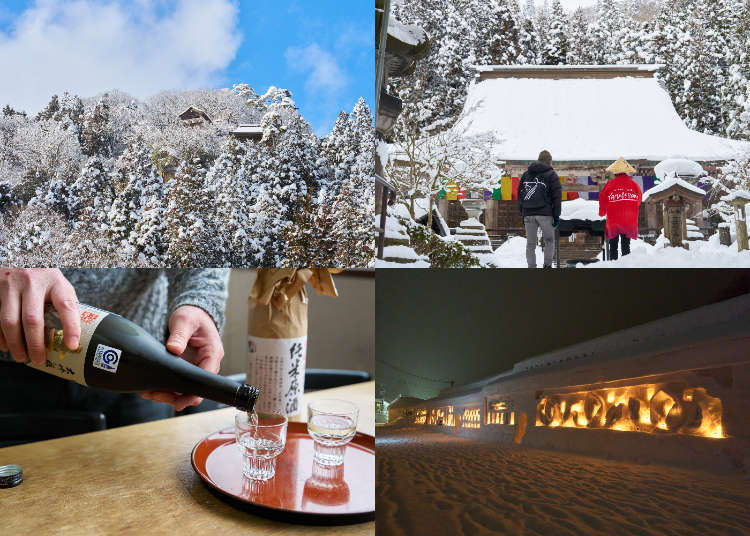
A 2-Day Winter Itinerary in Yamagata: Snowy Temples, Hot Springs & Local Sake
- Written by: LIVE JAPAN Editor
This time, I’d like to introduce Yamagata, known for places like Ginzan Onsen and Zao.
For those seeking a relaxing getaway rather than a fast-paced city trip like Tokyo or Osaka, Yamagata is an ideal destination filled with beautiful nature and incredible local food.
- Table of Contents
-
- Getting to Yamagata
- Yamadera (Risshakuji Temple): One of Yamagata’s Top Sights
- Enjoy Yamadera’s gourmet delights!
- Yamagata is synonymous with hot springs!
- Gassan Shizu Onsen
- Snow Lodging Lights
- A 95‑year‑old traditional inn: “Ochimizu-no-Yu Tsutaya”
- Otokoyama Sake Brewery — just a short walk from Yamagata Station
- The birthplace of chilled ramen: Sakaeya Main Shop
- If you’re shopping for Yamagata souvenirs: “0035 BY KIYOWAKAYA” & “0035 gather”
- Sample Yamagata sake and wine at “Yamagata Sake Tour ChettO”
- There are many more highlights to discover in Yamagata!
Hello! I'm Kim from the LIVE JAPAN editorial team.
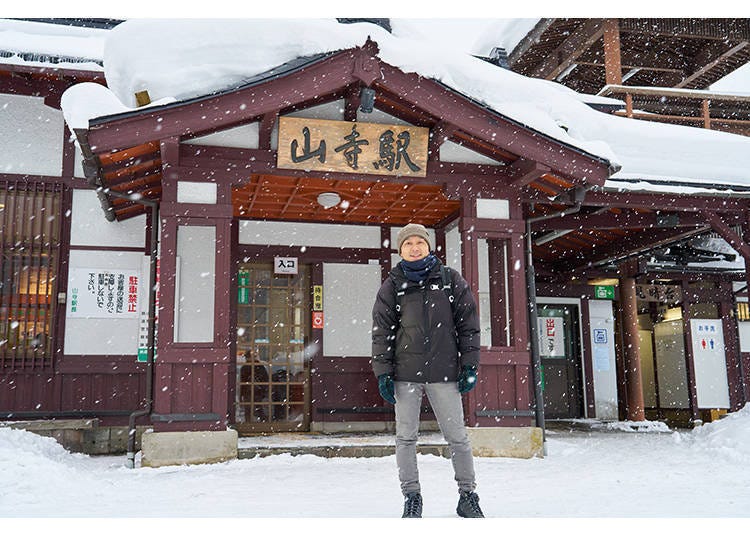
I usually work from the office or home, but right now, I’m in Yamagata Prefecture, in Japan’s Tohoku region.
And yes—my boss is here with me again.
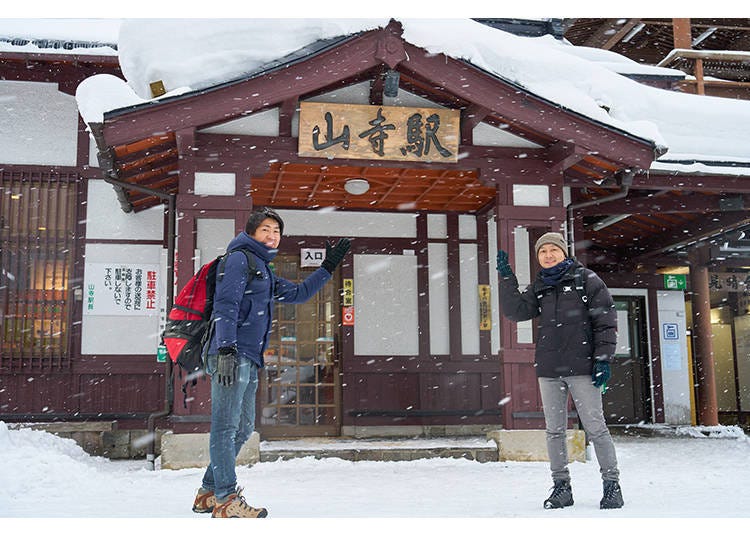
For some reason, they’ve joined me again.
This article is the second part of our 3-day, 2-night journey through Miyagi and Yamagata, this time covering our 2-day adventure in Yamagata.
You can check out Part 1, featuring Miyagi Prefecture, at the link below.
Getting to Yamagata
The direct bus from Sendai Airport is a convenient way to reach Yamagata Station, the hub for exploring the region. The ride takes about 1 hour 20 minutes and costs 2,000 yen one way per person.
(Daily Service) Sendai Airport → Yamagata Station
Departs from Stop 2 at Sendai Airport: 10 AM → Arrives 11:20 AM, 5 PM → Arrives 6:20 PM
(Daily Service) Yamagata Station → Sendai Airport
Departs from Stop 1 at Yamagata Station: 6:30 AM → Arrives 7:50 AM, 12:40 PM → Arrives 2 PM
If you're traveling to Yamagata after sightseeing in Sendai, both buses and trains are available. From the west exit of Sendai Station, the bus to Yamagata Station takes about 1 hour.
Depending on the time of day, there are 4 to 5 buses per hour. The fare is 1,100 yen one way per person (as of April 2025).
If you prefer to take the train, hop on the JR Senzan Line. The journey from Sendai Station to Yamagata Station takes about 1 hour 30 minutes, with a one-way fare of 1,170 yen per person.
For reference, traveling from Tokyo to Yamagata Station via the Yamagata Shinkansen takes as little as 2 hours and 22 minutes.
Yamadera (Risshakuji Temple): One of Yamagata’s Top Sights
Our first stop was Yamadera. Recognize this view? You may have seen it before: it’s one of Yamagata’s most iconic landscapes.
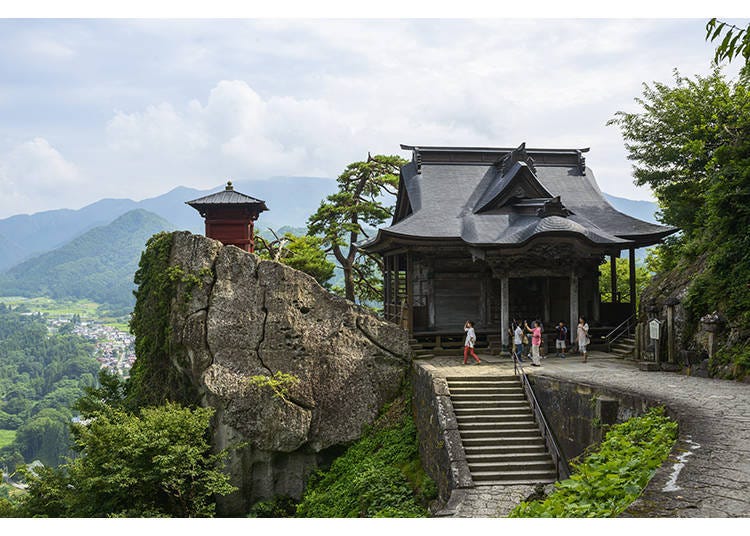
Roughly three-quarters of Yamagata Prefecture is mountainous, and many locals hold deep spiritual reverence for the land. Among its most sacred sites are the Dewa Sanzan, or Three Mountains of Dewa: Mt. Gassan represents the past and prayers for peace after death, Mt. Haguro symbolizes the present and worldly blessings, and Mt. Yudono stands for rebirth and the future.
Pilgrimage across these three peaks is known as a "journey of spiritual rebirth." Even today, ascetic mountain training is practiced here, and with advance registration, the public can take part in these unique experiences.
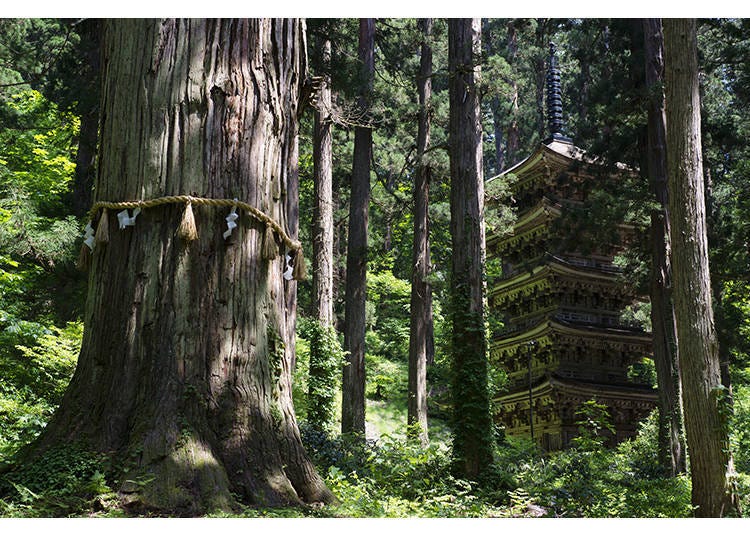
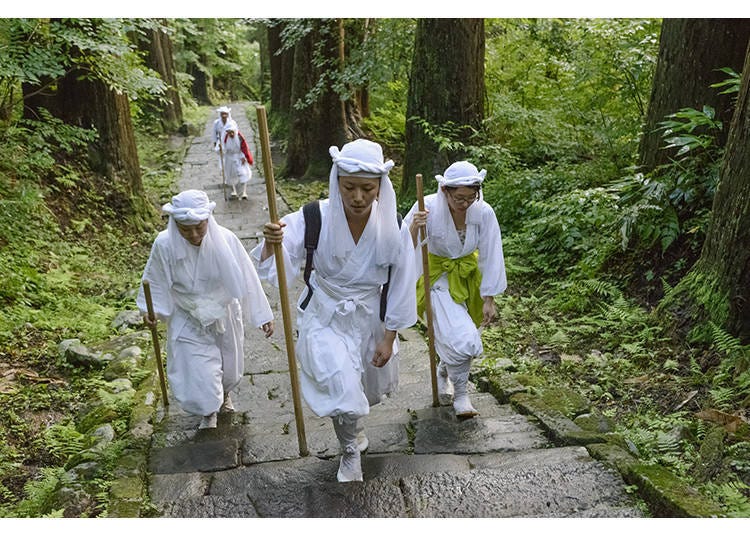
The Dewa Sanzan are so rich in history and spiritual depth that we can't possibly cover it all here; be sure to check the link below for more details.
Yamadera's official name is Hōshūzan Risshakuji, a temple of the Tendai sect founded in 860 by imperial request. The entire mountain, marked by dramatic rock formations, serves as a place of ascetic practice and devotion, where monks continue to train to this day.
Visitors can climb the 1,015 stone steps to reach the inner sanctuary. These steps are believed to help cleanse worldly desires with each stride. The round trip takes about 1.5 hours, and during snow-free seasons, regular sneakers are sufficient for the climb.
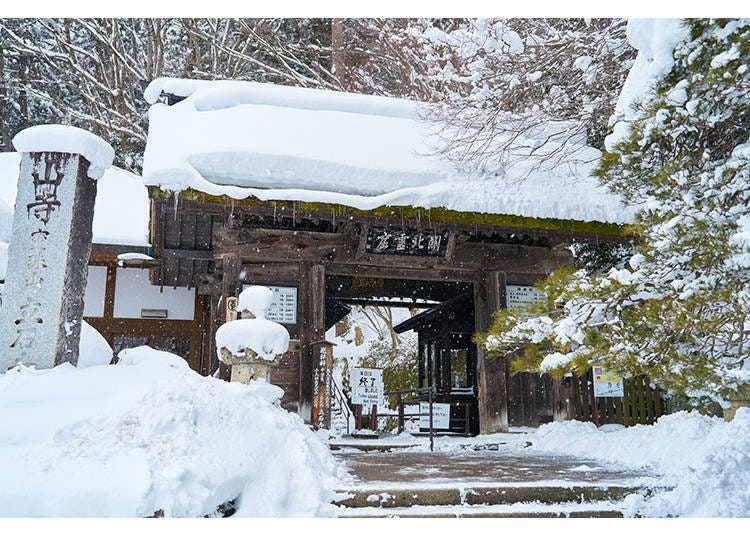
We were ready to take on the climb ourselves... but a record-breaking cold wave hit that day. Snow piled up to knee height in just one day, and with the mountain's entry hours nearly over, we had to give up.
From the top at Godaido, this is the view we would have seen...
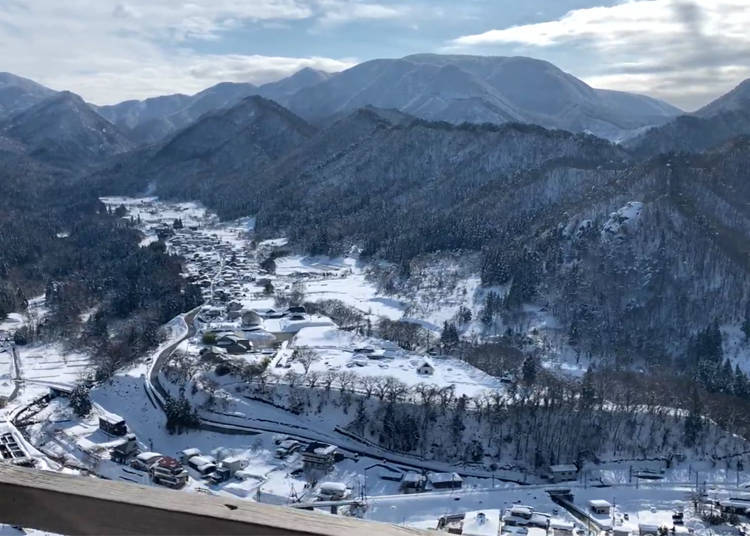
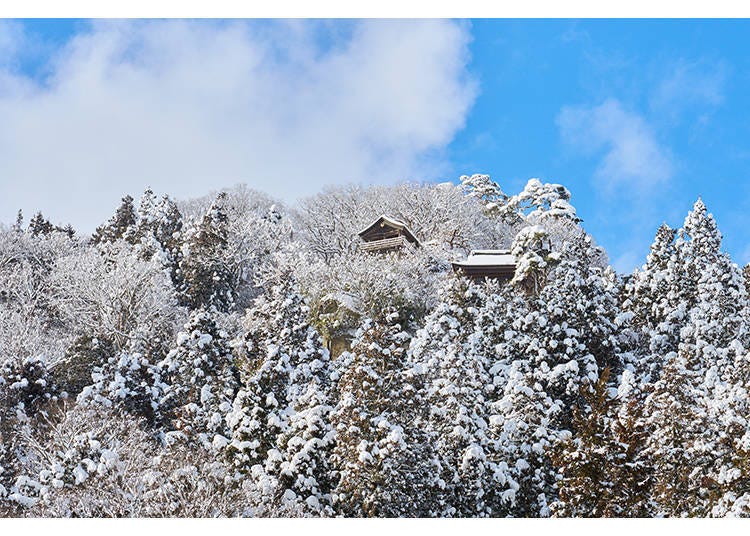
Most Japanese visitors come during autumn foliage season, weekends, or holidays, so winter visits are relatively rare. While Yamadera offers stunning views year-round, the snowy scenery in winter is truly special—definitely worth considering. Just be sure to wear proper hiking boots and bring crampons if there's snow.
I also recommend going with a local guide. This is a place of deep spiritual and historical significance, and climbing with a guide lets you experience the stories, traditions, and local life that you’d otherwise miss.
Yamadera is home to a passionate team of multilingual local guides known as the Yamaderans, a group dedicated to sharing their love and knowledge of the temple with visitors from around the world.
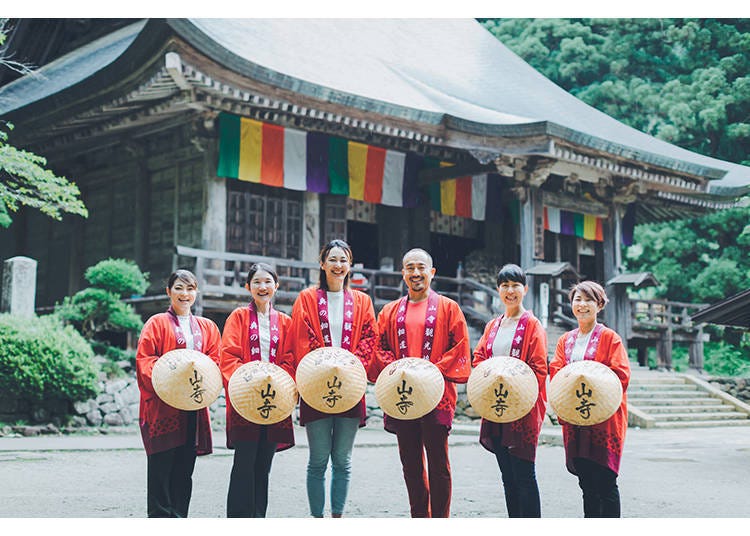
While the Yamaderans usually guide visitors all the way to the Okunoin at the summit, this time we requested a special short tour just around the mountain gate area.
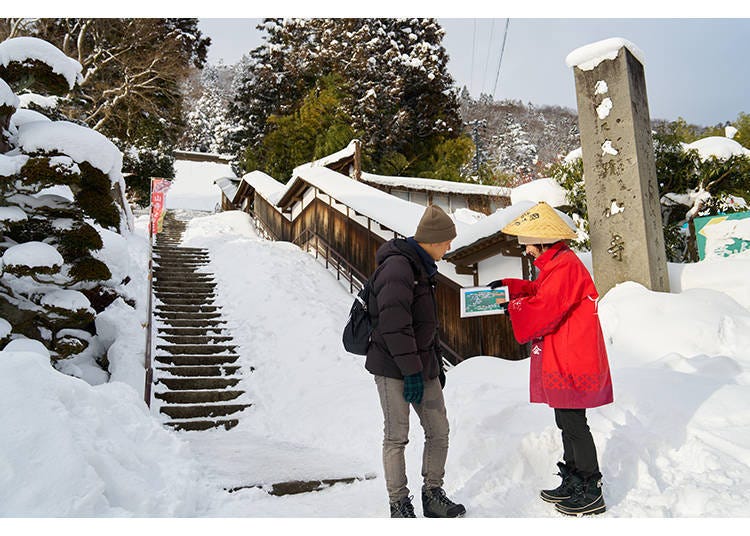
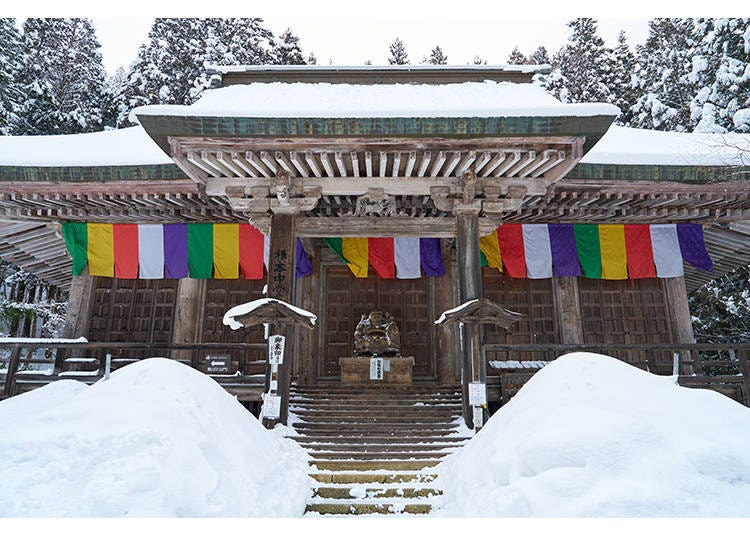
Inside the Konpon Chudo, an eternal flame has been burning continuously for nearly 1,200 years. (Isn’t that incredible?) While the hall is closed during winter, it’s open for visitors from spring through autumn.
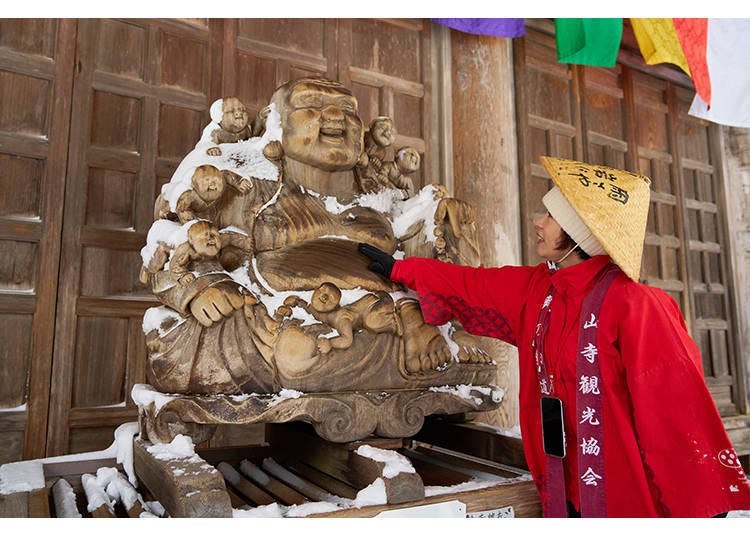
At the entrance, you’ll find an adorable “Fat Buddha” (Shofuku Hoteison), said to bring good fortune. It’s believed that if you gently rub his body while making a wish, it will come true. His surface is smooth and shiny from all the well-wishers.
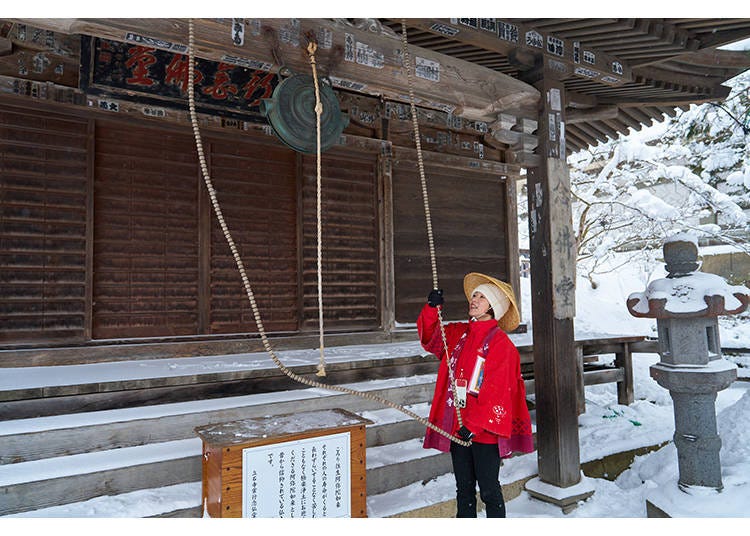
There are spots you might easily overlook without a guide, but learning the background changes your entire perspective. These places have been built, cherished, and preserved by generations past. Walking through Yamadera with that sense of respect was a truly meaningful experience.
Yamaderans currently offer guided tours in English. You can book online using the link below. In winter, contact them directly by email. For those joining a tour during the snowy season, they also offer free rental of crampons—just ask when booking.
Book a Yamaderans Guide
Tips for Climbing Yamadera
1. Travel light. Use coin lockers at Yamadera Station to store unnecessary items.
2. Admission is 300 yen per person. The round-trip hike takes around 1.5 hours.
3. Plan with extra time in mind, especially in autumn and winter.
4. Wear sturdy, slip-resistant shoes in winter. Steps can be icy and dangerous, so caution is key.
-

-
Address
4456-1, Yamadera, Yamagata-shi, Yamagata, 999-3301
View Map -
Nearest Station
Yamadera Station (Senzan Line)
5 minutes on foot
- Phone Number 023-695-2843
-
Address
4456-1, Yamadera, Yamagata-shi, Yamagata, 999-3301
Enjoy Yamadera’s gourmet delights!
When visiting Yamadera, be sure to try these local delicacies!
Ita soba and squid-leg tempura soba
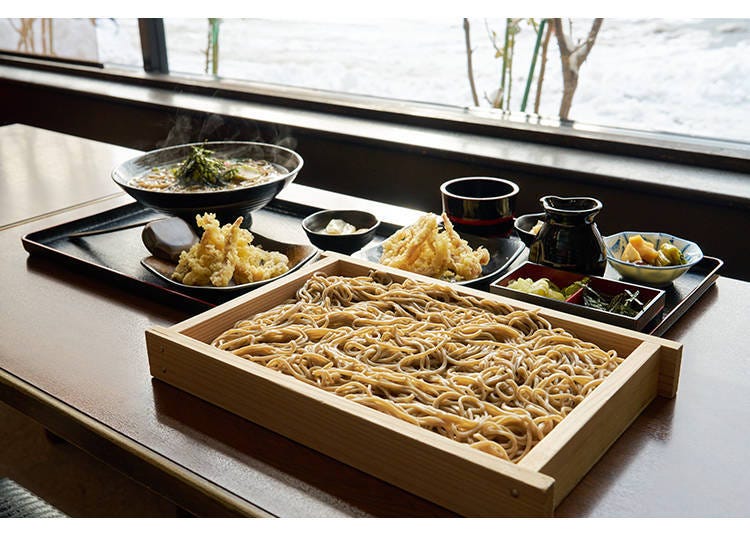
We visited “Fumotoya Main Shop,” which can accommodate vegetarians and vegans with advance reservations. Yamagata is so famous for soba that it calls itself the “soba kingdom,” and ita soba is a local specialty. The noodles are slightly thicker and served in generous portions—what you’d call one serving in Tokyo feels like two here. “Geso‑ten” refers to tempura made from squid legs. The dish originated from cutting up and frying surume (dried squid, a preserved food) in this region. It’s delicious to eat together with the soba, and it also tastes great simply with salt!
Our boss had hoped to try dashi soba, a refreshing summer dish topped with a finely chopped mix of cucumbers, eggplants, and aromatic herbs like shiso and myoga. Unfortunately, it’s only available in the warmer months. Another summer favorite is cold meat soba—definitely something to look forward to trying when the weather warms up.
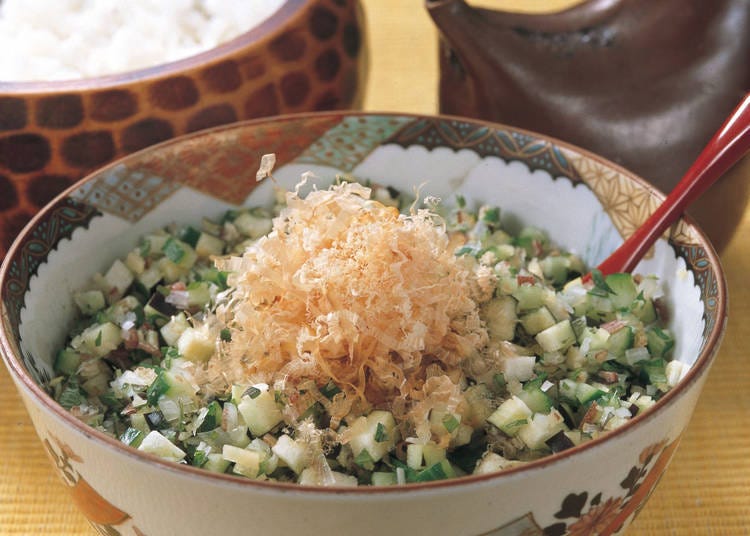
Chikara konnyaku
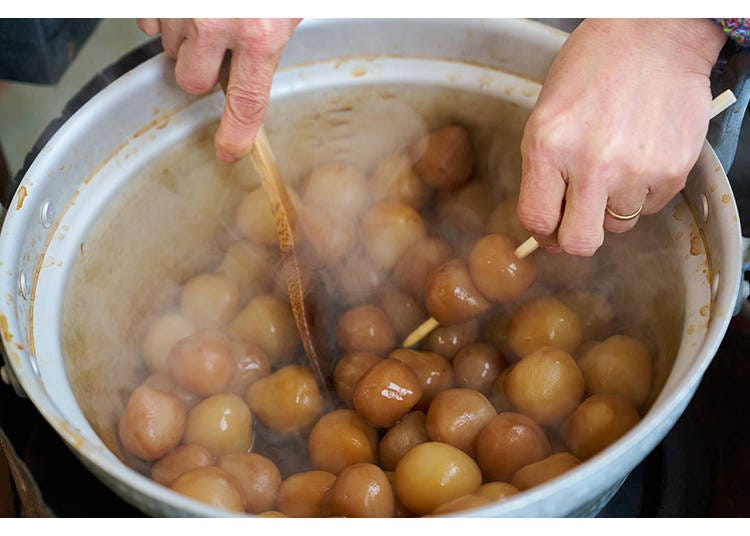
These are konnyaku balls simmered in a soy‑based broth. Enjoy These are konnyaku balls simmered in a soy-based broth. Enjoy them with a dab of spicy mustard if you like. Some shops serve them already skewered, while others let you skewer them yourself. They have a completely different texture from the konnyaku jelly often bought as a Japanese souvenir—chewy and bouncy with each bite. Try them before climbing the 1,015 stone steps! The warmth will give you energy.
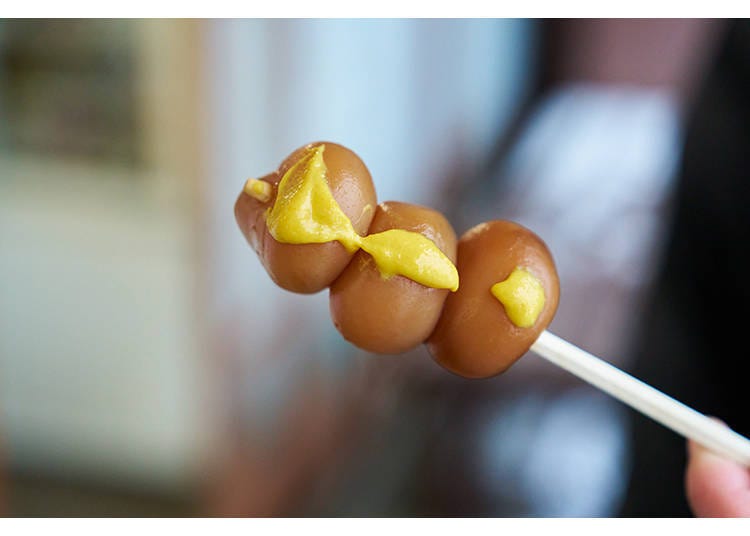
Imoni stew
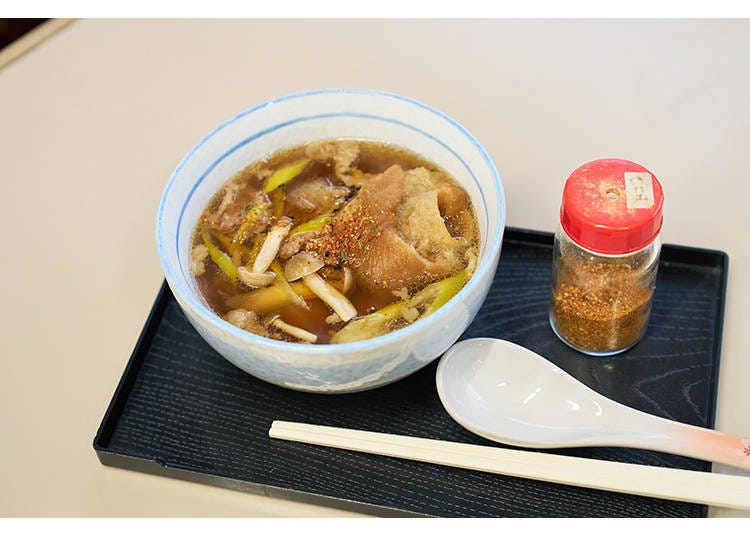
Imoni is a local dish that Yamagata residents can’t live without. When taro root is in season in autumn, people gather along the river as if they’re having a barbecue, cook imoni in a pot and share it together. These gatherings are called “imoni parties,” and supermarkets even sell complete ingredient sets and rent out pots and cauldrons. It really is a soul food! Whether the broth should be soy sauce or miso based, or whether the meat should be beef or pork—that’s the kind of debate this beloved dish sparks.
Yamagata’s love of imoni knows no bounds. Every September the “Japan’s Largest Imoni Festival” is held on the riverbank in Yamagata City. A giant pot 6.5 meters in diameter nicknamed the Third‑Generation “Nabe Taro” is stirred with a construction crane to cook around 30,000 servings of imoni—an incredible sight! That’s the Imoni Festival. Come along, watch the spectacle, and eat your fill!
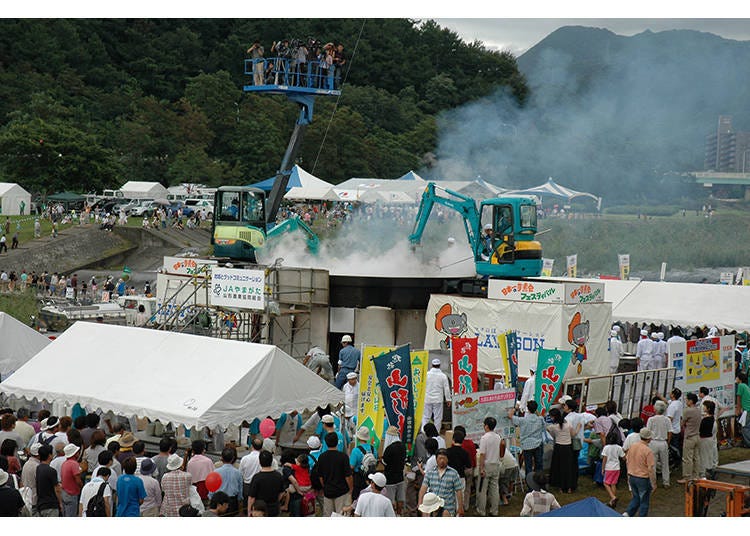
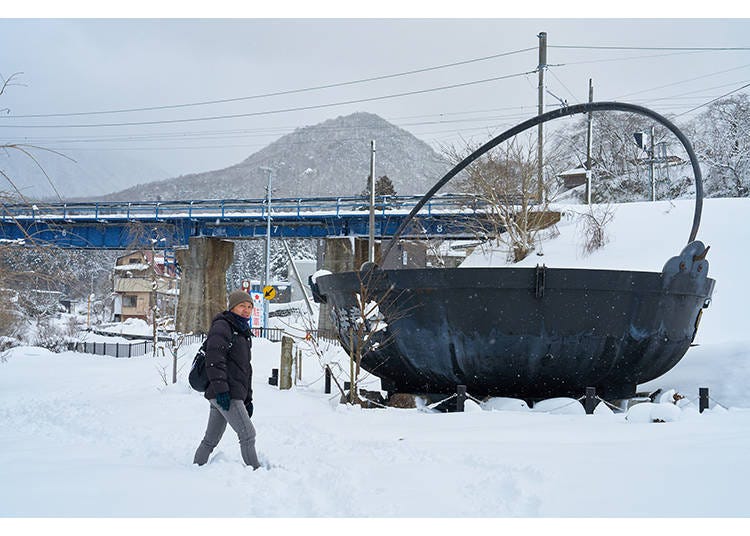
Getting to Yamadera
We recommend taking the train. If the Senzan Line is suspended due to strong winds or heavy snow, a replacement bus service is available.
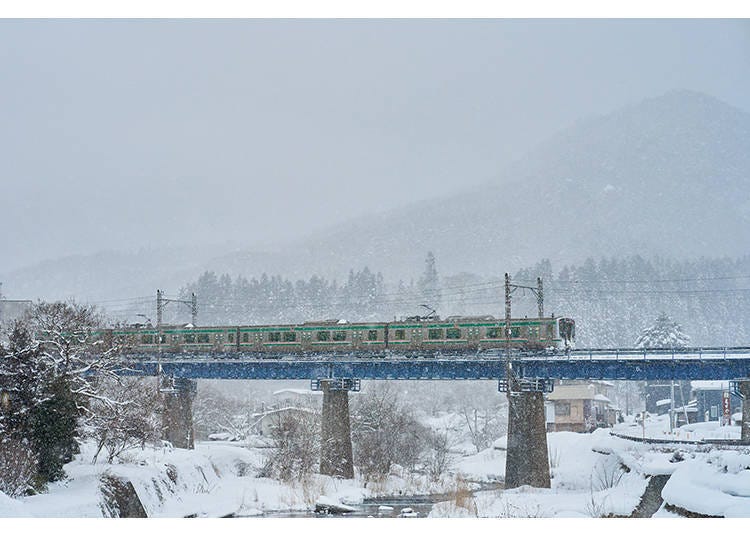
Train: Take the JR Senzan Line to Yamadera Station—about 20 minutes from Yamagata Station and around 50 minutes from Sendai. From Yamadera Station it’s roughly a 10‑minute walk to the area where Yamadera (Risshaku‑ji Temple) is located.
Bus: On weekdays, Yamakō Bus route D56 departs from stop 2 in front of JR Yamagata Station for Yamadera Station. Reservations are not required. Buses leave at 9:37 AM, 11:27 AM, 1:27 PM, 3:27 PM and 5:27 PM, and the ride takes about 40 minutes. (The times above are current as of March 2025; please check the link below for the latest schedule.)
By rental car: about 30 minutes from JR Yamagata Station and 60 minutes from Zao Onsen. There is parking nearby.
Yamagata is synonymous with hot springs!
After that we headed to JR Yamagata Station, the prefecture’s central hub. Yamagata is a “hot spring prefecture” where every city and town has a spring. Ginzan Onsen is famous worldwide for its nostalgic atmosphere, but in recent years, overtourism has become an issue. Zao Onsen is spectacular in February when the frost‑covered "snow monster" trees are at their best, but even on weekdays, it’s getting hard to find a room. So this time we chose a lesser‑known hot spring area where you can relax more easily.
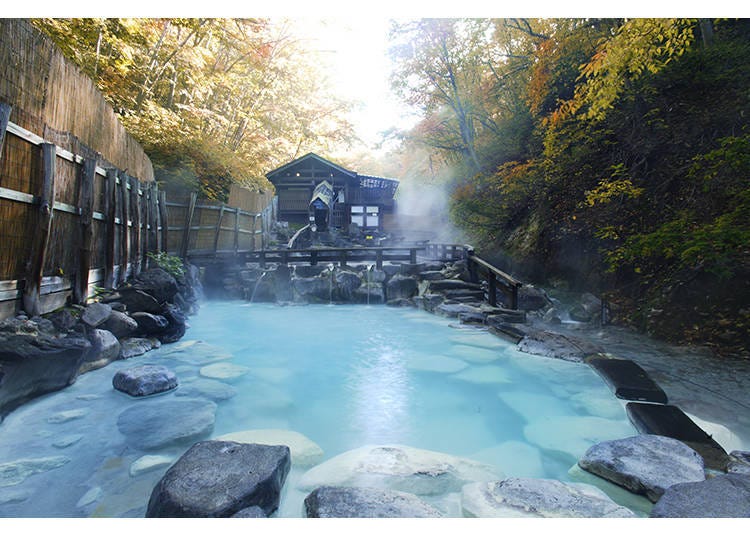
Gassan Shizu Onsen
We headed to Gassan Shizu Onsen, a historic hot spring village that once prospered as a lodging town for pilgrims to the Three Mountains of Dewa. There happened to be an evening event during our visit, so our boss chose it—something to look forward to! “It’s about 50 km from here, though,” he laughed.
We took a highway bus from Yamagata Station and got off at the Nishikawa Interchange, then transferred to a flat-rate taxi we’d booked in advance. Yeah, our boss’s itinerary felt like something for seasoned Japan travelers. “I’m not used to driving in winter,” he explained. “Taking public transport makes this the quickest route. At other times of year I’d just rent a car.” There’s a direct bus from Yamagata Station on weekends when the event is held, too. When I asked if we were really going all that way just for the event, he added, “That’s part of it, but did you know Gassan Shizu Onsen is said to be one of the snowiest places in Japan? They get up to six metres of snow! Isn’t that incredible?”
Snow Lodging Lights
Held on winter evenings from early to late February each year, this event uses the deep snow to recreate streets lined with old inns and illuminates them with candlelight. It has been running for about 20 years.
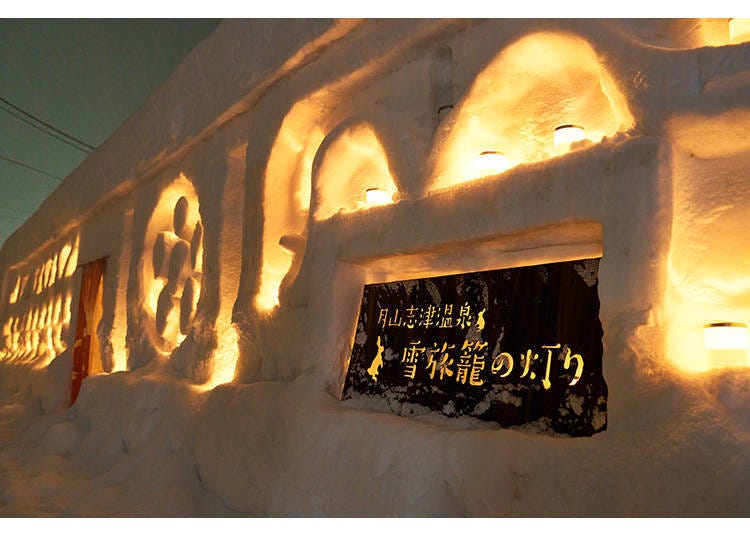
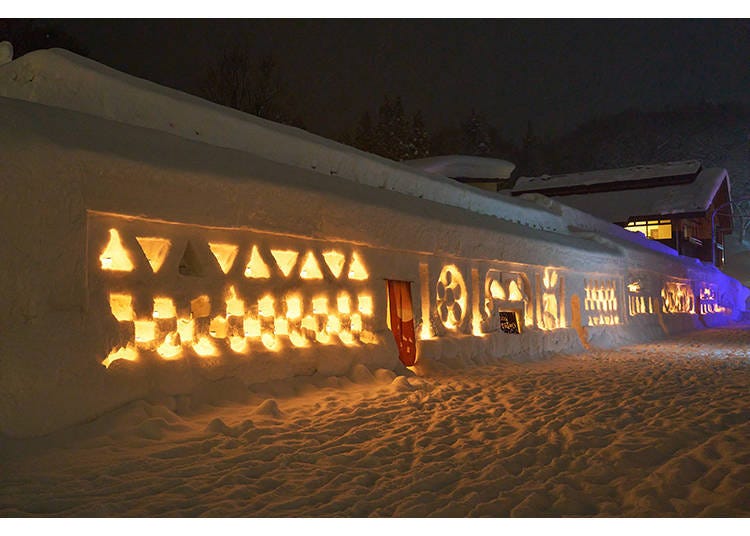
Everything here is made entirely of snow! They say they use heavy machinery like shovels and excavators to build it, but it must be tough working outside in the cold.
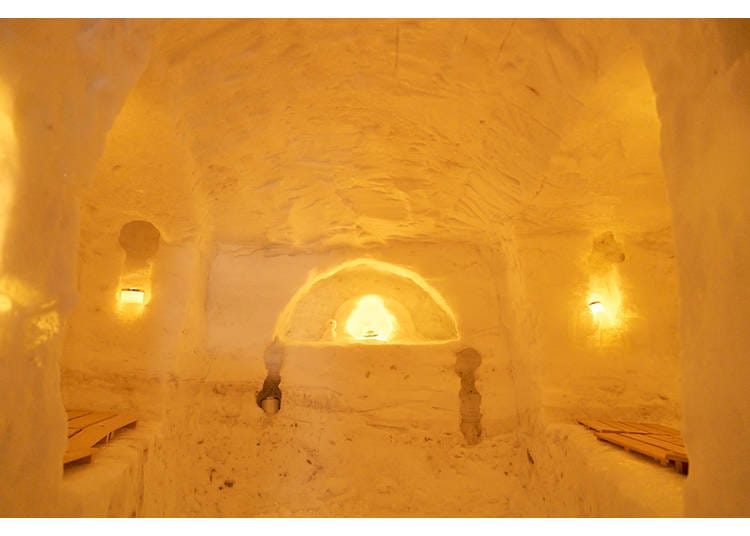
We ducked under the noren curtain and went inside the snow lodging. Believe it or not, there was even an ICE BAR!
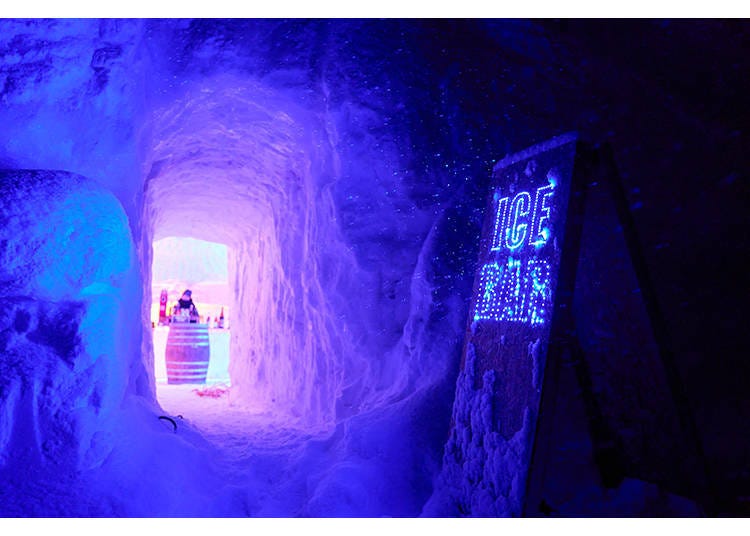
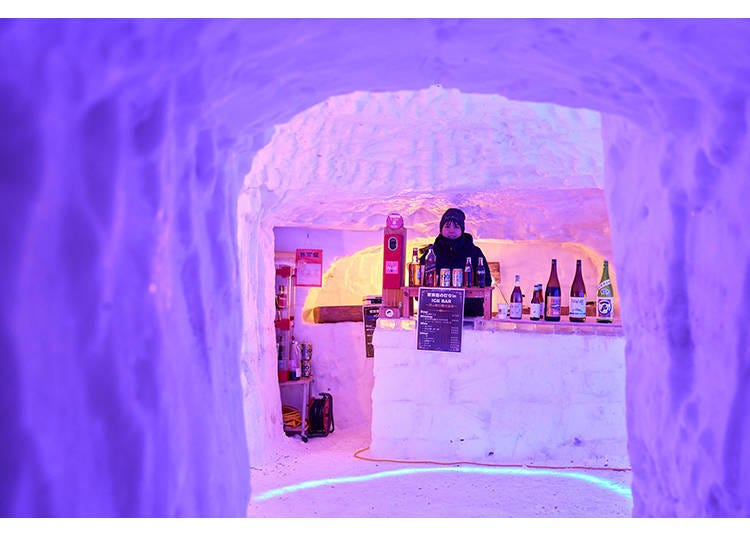
We sipped hot wine and chatted with the staff. The place is busiest around dinner time at the inn, and weekends are busier than weekdays. On weekends the bar owner comes, so the ICE BAR has an even larger selection of drinks! You can try local beverages like Gassan craft beer, the regional wine "Gassanroku Shaian," and the sake "Hito-Koe" while enjoying conversation with locals and other travelers – it’s great fun! You might not get to experience such a huge snow structure anywhere else. Even in the bitter cold you can still feel a sense of warmth, which makes it really wonderful.
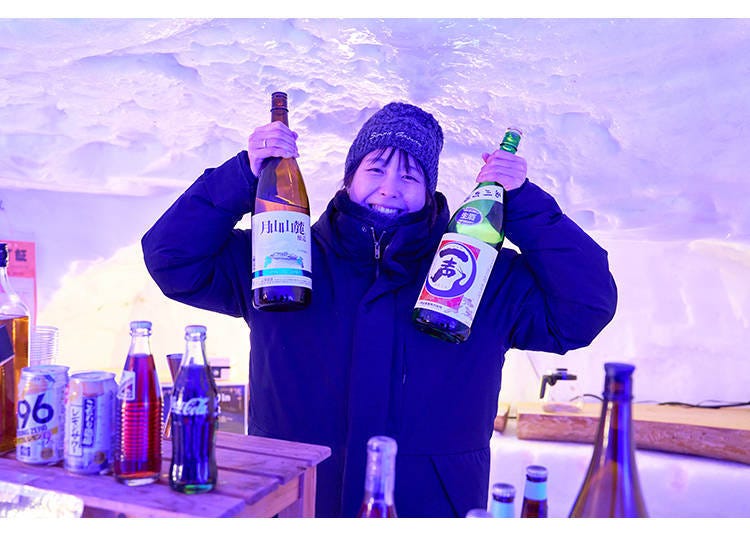
A 95‑year‑old traditional inn: “Ochimizu-no-Yu Tsutaya”
There are about ten inns within walking distance of the event venue, and tonight we are staying at Ochimizu-no-Yu Tsutaya. The name "ochimizu" (literally, "water of rejuvenation") refers to water said to restore youth when you drink it. The snow of Mount Gassan becomes life‑giving water, and that water nourishes edible wild plants and mushrooms. This former post town has long welcomed pilgrims to the Three Mountains of Dewa with cuisine featuring mountain vegetables.
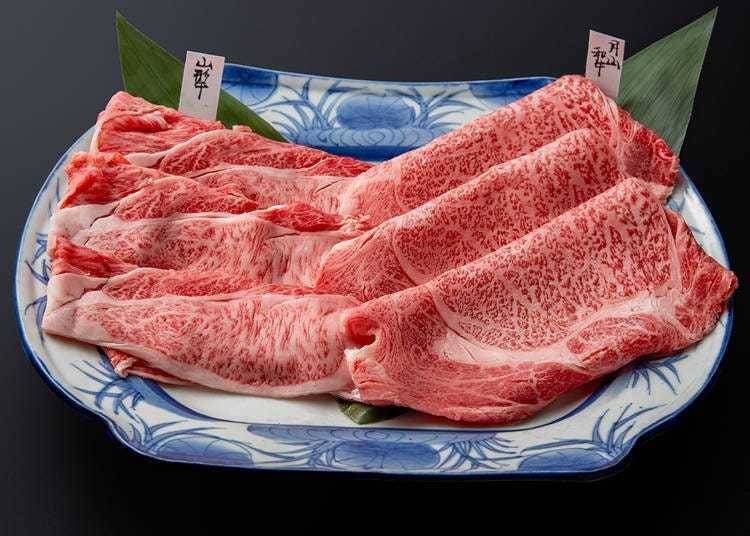

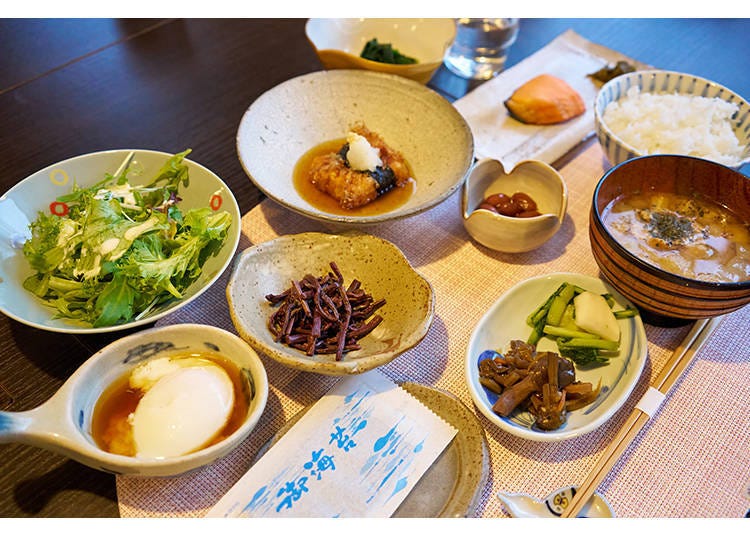
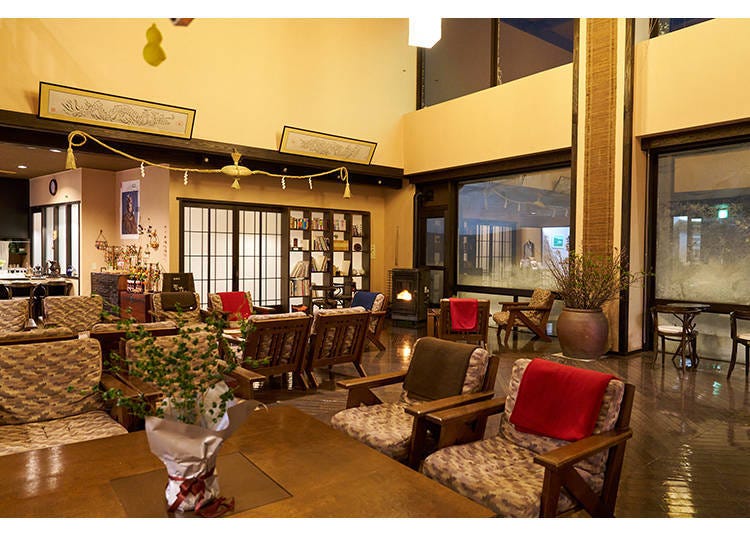
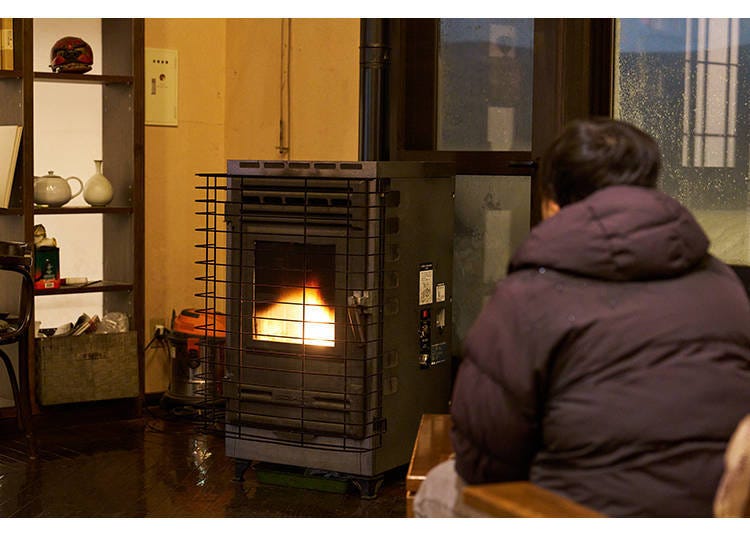
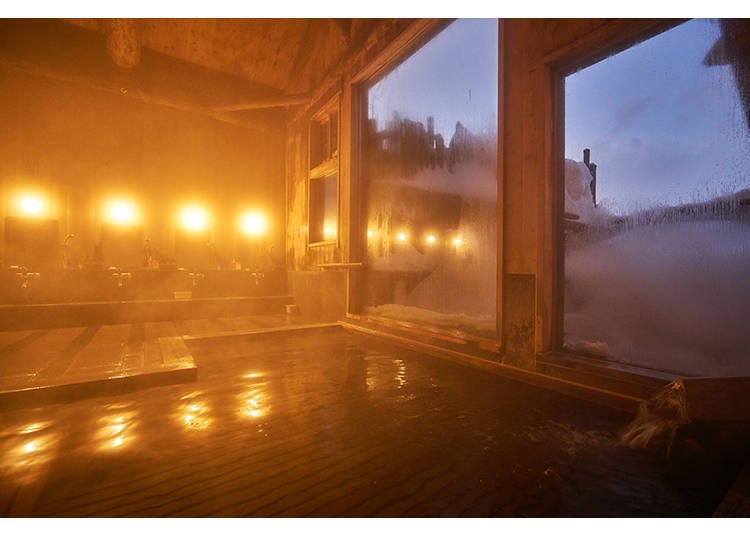
-
Ochimizu-no-Yu Tsutaya変若水の湯つたや
- Address 10 Shizu, Nishikawa Town, Nishimurayama District, Yamagata Prefecture
Day‑use bathing, private baths and private steam baths (saunas) are also available.
Vacancy search, reservation
-
from 49,800JPY 1room, 2adults
Check with our partner site as the latest rates, rate details, and guest room requirements may vary.

(I’ve never seen this much snow piled up before.)
Otokoyama Sake Brewery — just a short walk from Yamagata Station
We retraced our route back to Yamagata Station. Today we’ll do some sightseeing around the station until it’s time to catch our Shinkansen home.
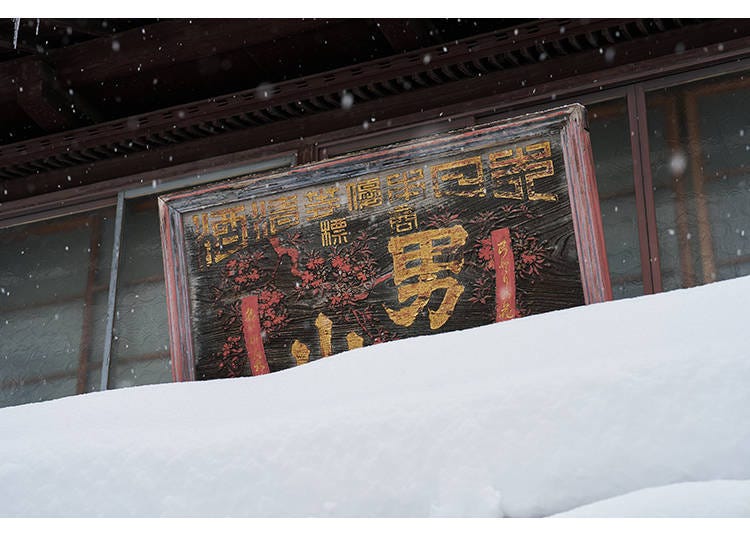
Our first stop was Otokoyama, a venerable sake brewery founded in 1789. It’s within walking distance of the station, and if you book ahead you can tour the brewery – and amazingly, it’s free. Brewing takes place from January through March, and you can watch all nine brewers at work. Even though they were busy, everyone took the time to greet us.
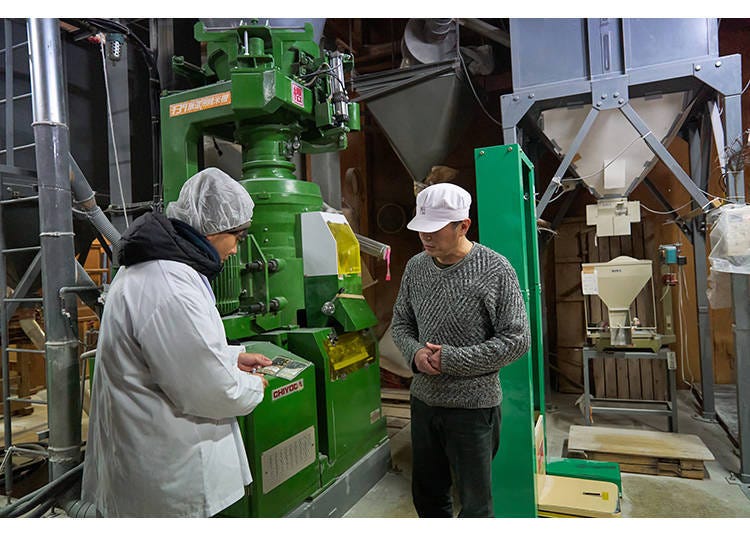
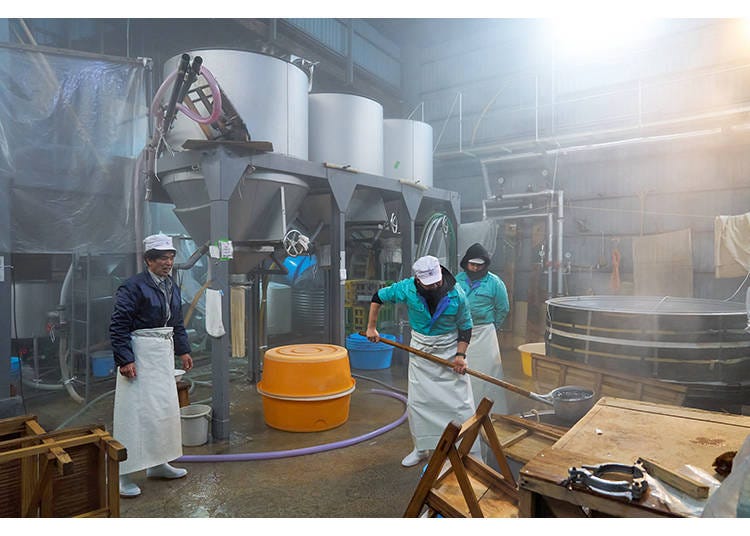
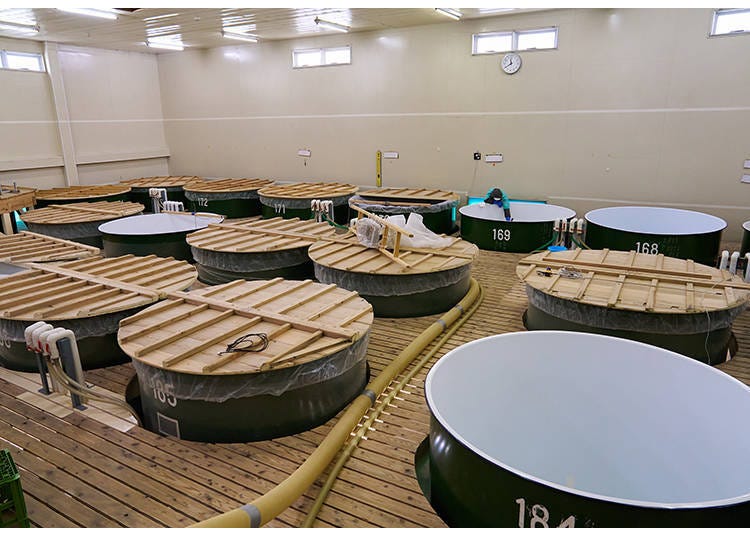
Plan on spending about 40 minutes for the tour. Afterwards, you'll enjoy a delightful tasting session.
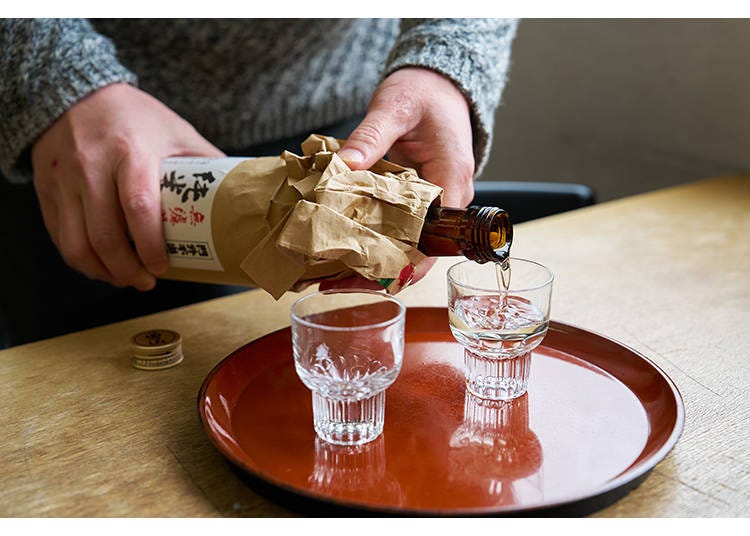
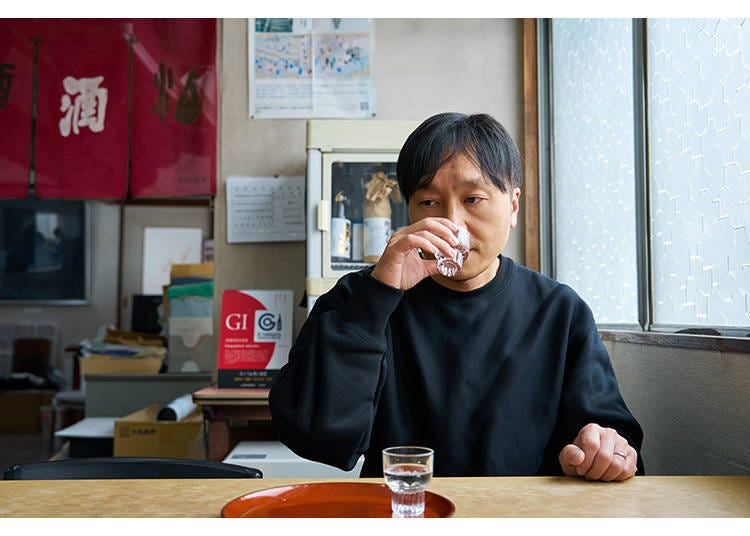
This brewery produces 20‑30 varieties of sake and lets you sample some of them. If you find one you like, you can even buy it on the spot—but be aware they only accept cash. (Our boss bought an unfiltered junmai genshu and someone ended up finishing it!)
More people are enjoying whisky these days and taking tours of Japan’s distilleries. The number of sake lovers is also growing, and interest in brewery tours like this is on the rise. Yamagata in particular has pure water and many wonderful sakes. Taking a tour like this and discovering a sake you love is one of the pleasures of travel.
-
Otokoyama Brewery男山酒造
- Address 山形県山形市八日町2丁目4−13
Tours are available on weekdays from 10 AM to 4 PM (excluding Sundays and holidays). Advance reservations by phone are required, and groups of up to around 20 people can be accommodated.
The birthplace of chilled ramen: Sakaeya Main Shop
For three consecutive years through 2023, Yamagata City has spent more on eating out at ramen restaurants than anywhere else. Yamagata Prefecture even bills itself as the "ramen prefecture," and Yamagata City as a "ramen mecca." Ramen is so much a part of life here that people often order it in to serve guests. The dominant style is soy sauce‑based chūka soba, and many soba restaurants also offer ramen, which shows just how beloved it is.
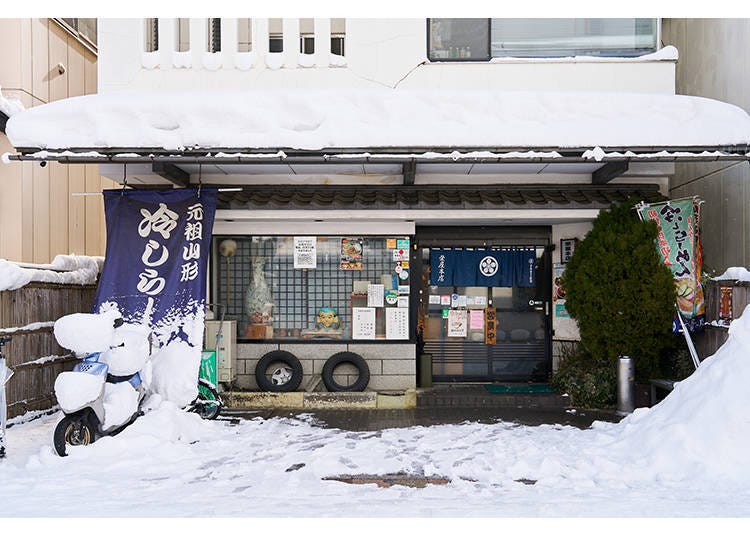
The shop opened as a soba restaurant in 1932 and added Chinese noodles to the menu in 1949. In 1952, they created “chilled ramen (hiyashi ramen)” after a customer said, “We eat cold soba in summer, so I’d love to try cold ramen too.” And now our cold ramen has arrived!
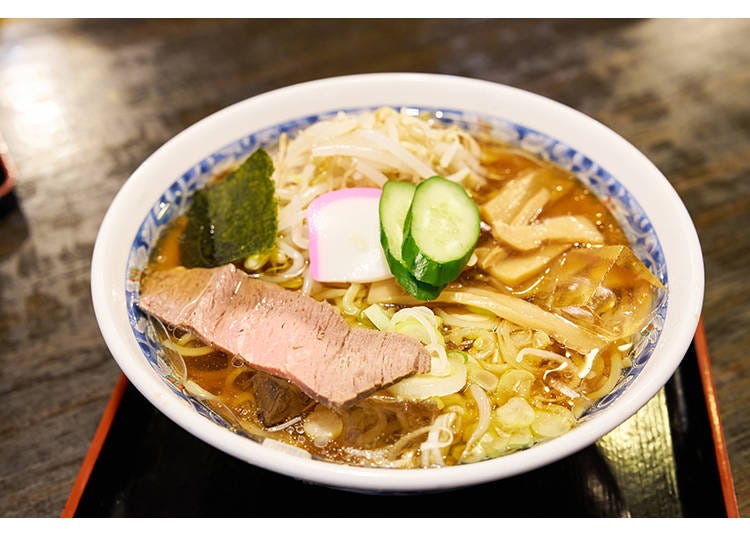
This soy sauce‑based chilled ramen comes with cucumber and even ice floating on top. They spent a year developing a broth that doesn’t congeal. Unlike cold hiyashi chūka noodles without soup, this isn’t sweet and sour—the broth is rich with dashi. You can order it year‑round here, so if you visit Yamagata be sure to try it.
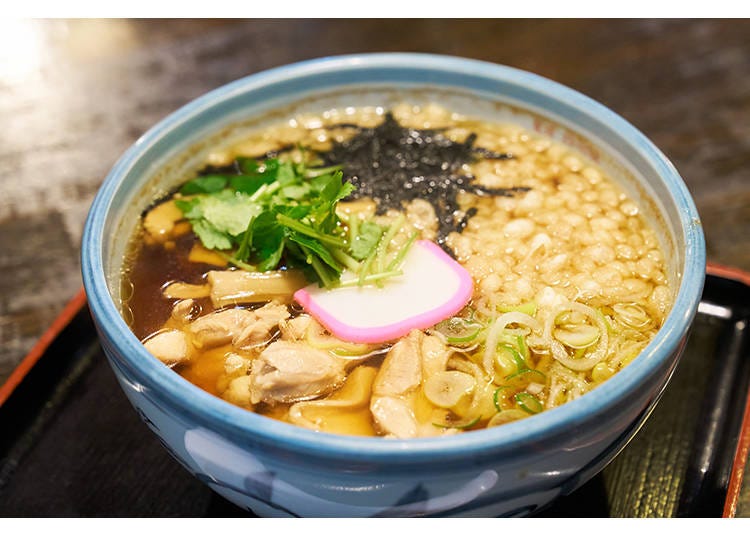
My boss ordered “Tori‑chūka.” This ramen is also said to have originated in Yamagata, created by soba restaurants. It features ramen noodles served in a Japanese‑style broth similar to soba dipping sauce. I had a taste, and it was delicious too.
-
Sakaeya Main Shop栄屋本店
- Address 2-3-21 Honcho, Yamagata City, Yamagata Prefecture
・Hours: 11:30 AM–6:30 PM. Closed Wednesdays.
If you’re shopping for Yamagata souvenirs: “0035 BY KIYOWAKAYA” & “0035 gather”
Our next stop was a select shop with a cafe located a two‑minute walk from Yamagata Station. It carefully curates and sells attractive products from Yamagata’s 35 cities, towns and villages. The shop is divided into two adjacent sections; “0035 gather” features a wide array of Yamagata handicrafts that exude the warmth of human touch. In the sophisticated setting you can take your time and choose at leisure.
From the outside you might wonder whether it’s a place displaying expensive crafts and whether it’s okay to go in, but please feel free to pop in. In fact there are plenty of reasonably priced items too, so you may find the perfect souvenir of your Yamagata trip.
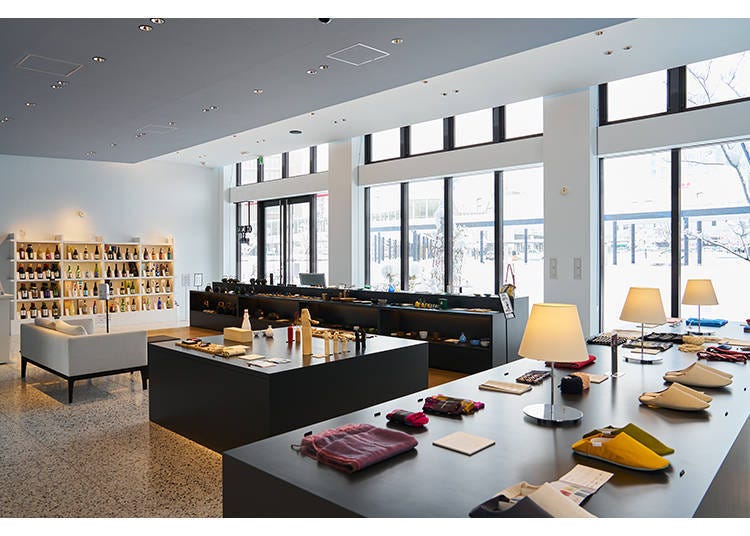
A popular souvenir among foreign travelers is the “Otaka Poppo.” It’s a traditional folk craft from Yonezawa City, and its cute design makes it great for your decor.
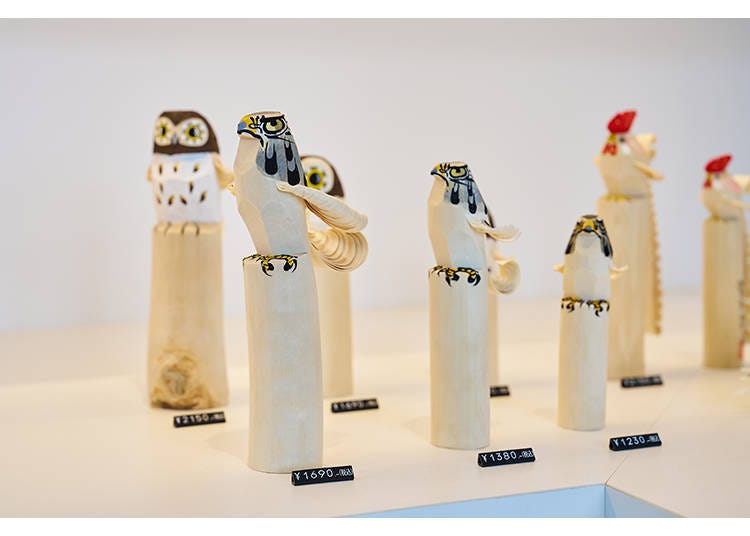
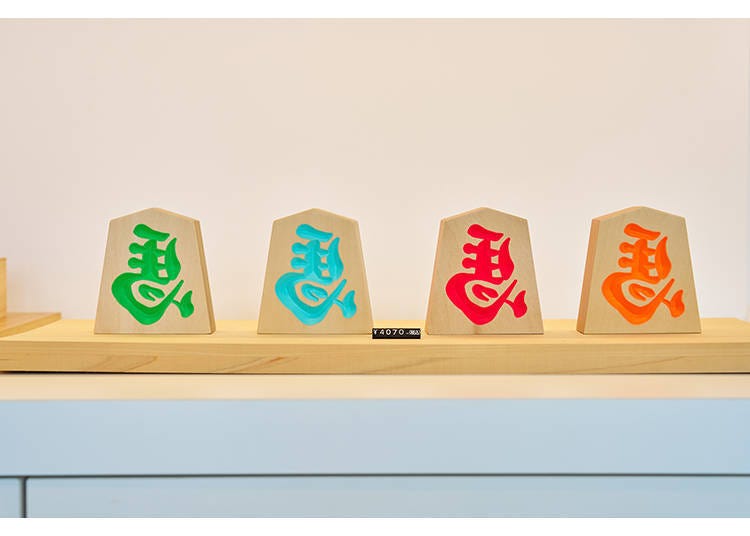
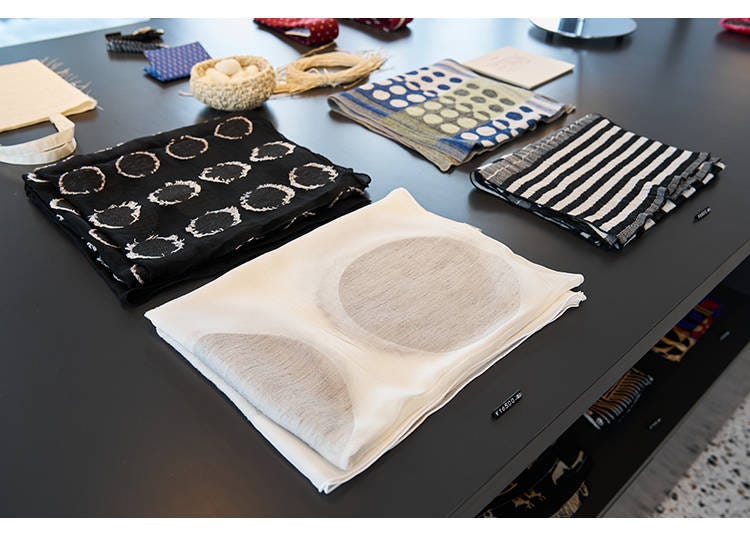
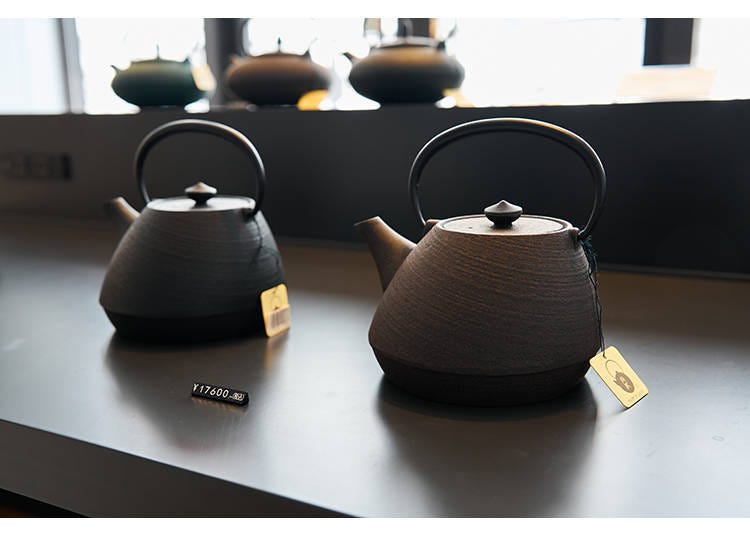
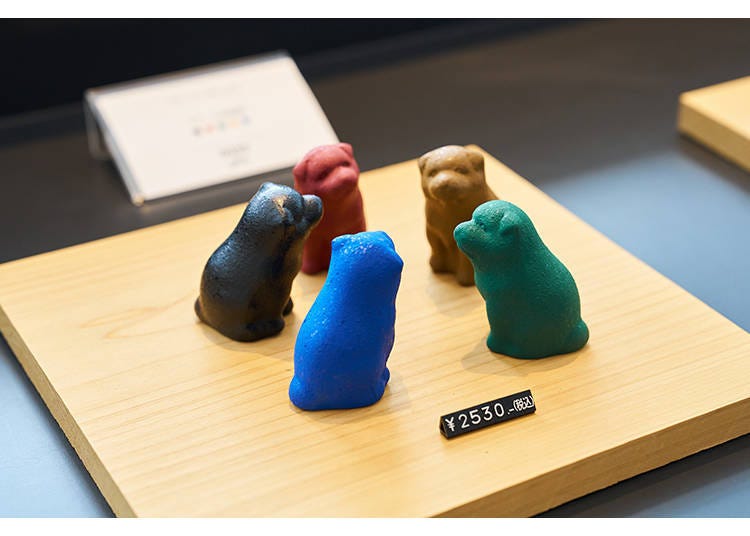
They also stock sake from across the prefecture. You can pay to taste different sakes, and on this day there were about 30 varieties available.
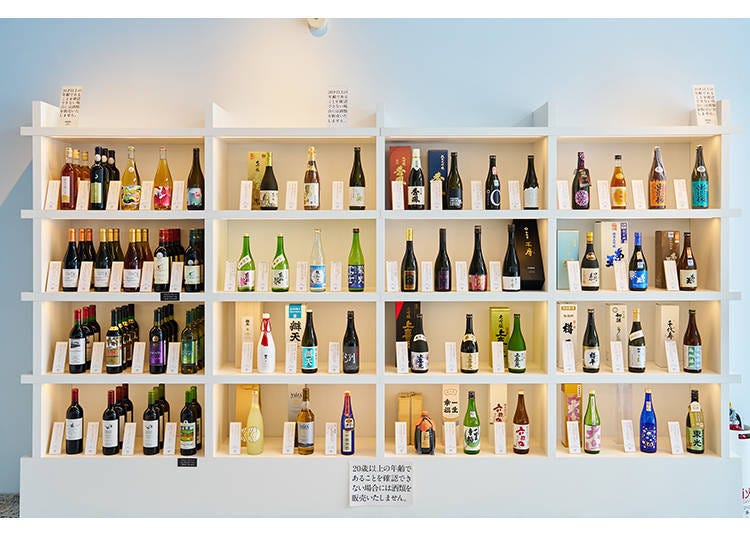
The adjacent shop “0035 BY KIYOWAKAYA” brings together the best of Yamagata. We asked the staff about popular souvenirs among foreign visitors, so here are their recommendations!

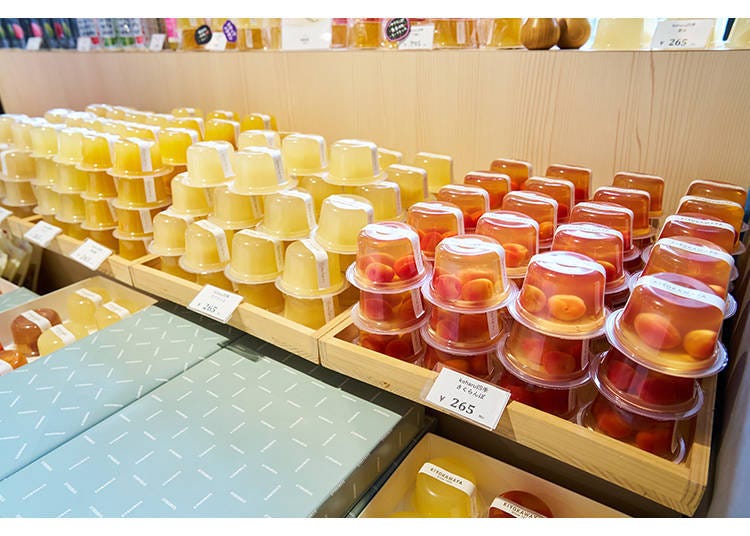
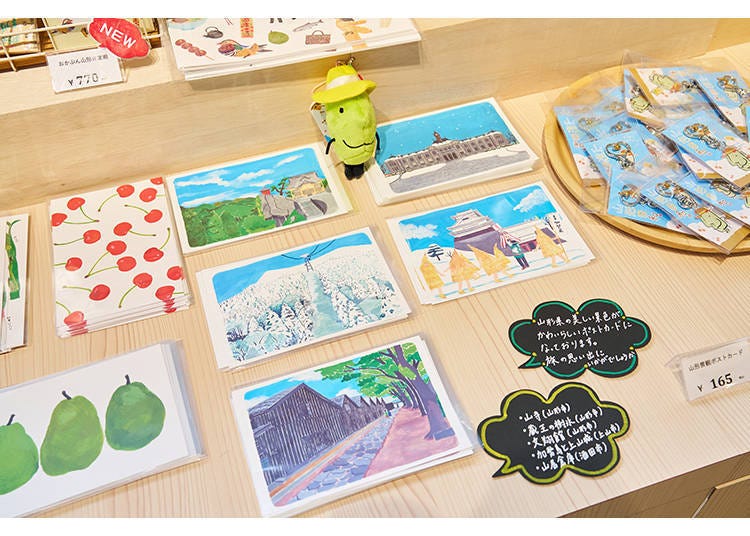
It’s also nice to relax in the adjoining cafe. They sell seasonal fruit sandwiches, Zao beef croquette sandwiches, and even three kinds of steamed buns filled with ramen—a first in Japan! As you would expect from Yamagata, the kingdom of ramen.
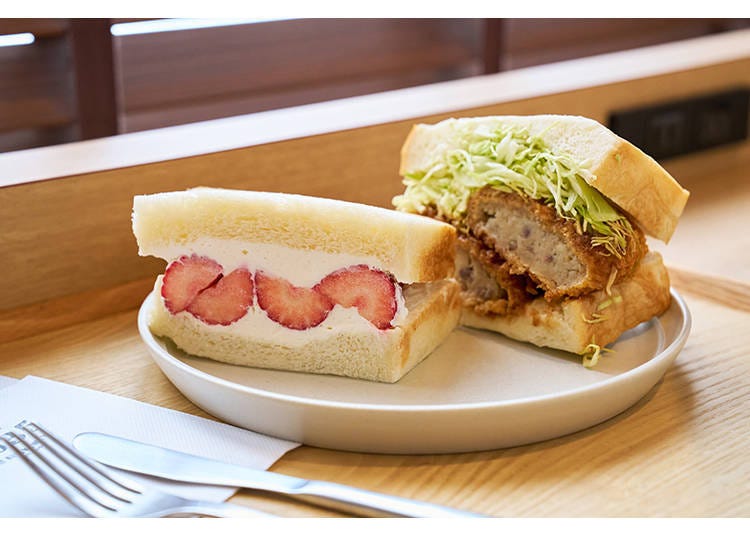
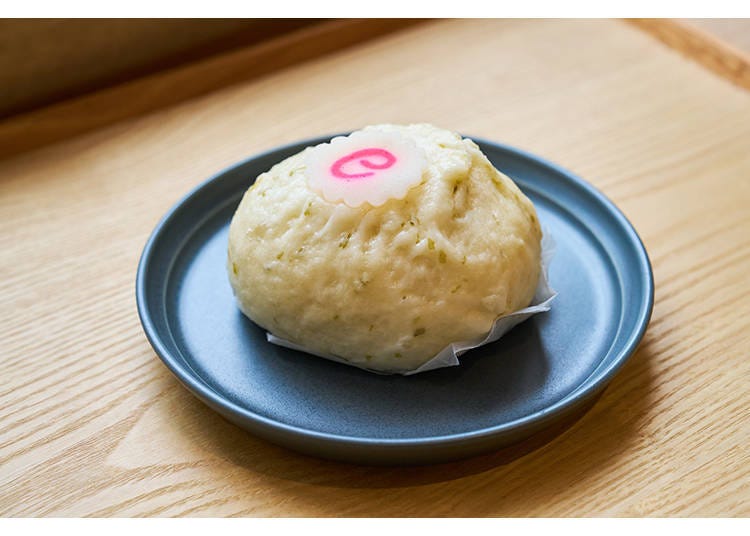
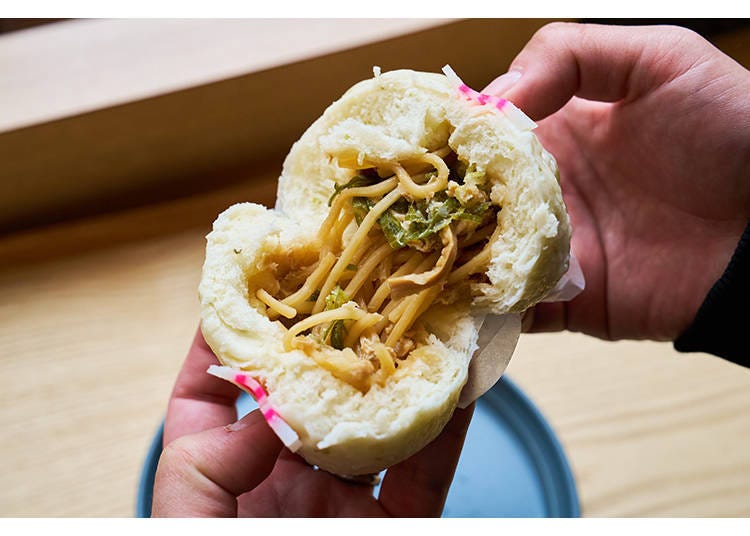
This steamed bun reminds me of Korean hoppang. The usual fillings are red bean paste, meat, vegetables or cheese, but here it’s stuffed with ramen! Only in Yamagata, where they eat more ramen and soba than anywhere else.
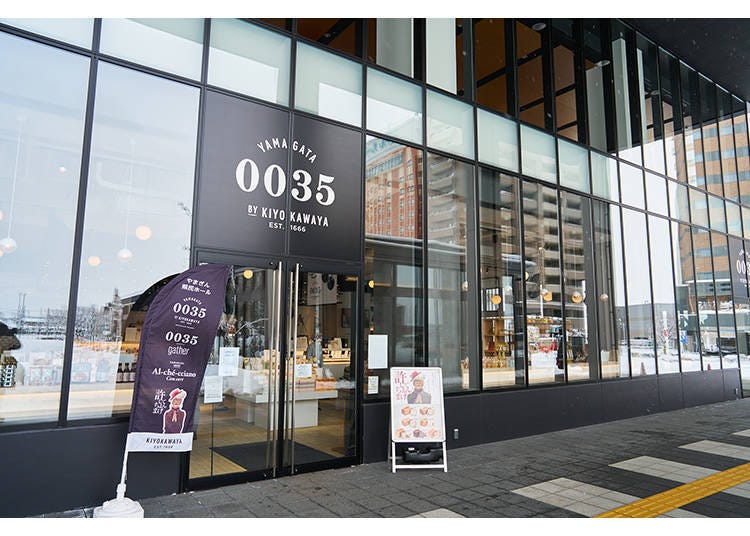
-
0035 BY KIYOWAKAYA / 0035 gather0035 BY KIYOWAKAYA / 0035 gather
- Address 1F, Sogo Bunka Geijutsu-kan (Yamagin Kenmin Hall), 1-2-38 Futaba-cho, Yamagata City, Yamagata Prefecture
・Hours: 10 AM–6 PM
・Closed: Tuesdays in winter
Sample Yamagata sake and wine at “Yamagata Sake Tour ChettO”
Our last stop was “Yamagata Sake Tour ChettO,” located in a building you can reach from the station without stepping outside. This adult-oriented facility opened in 2024.
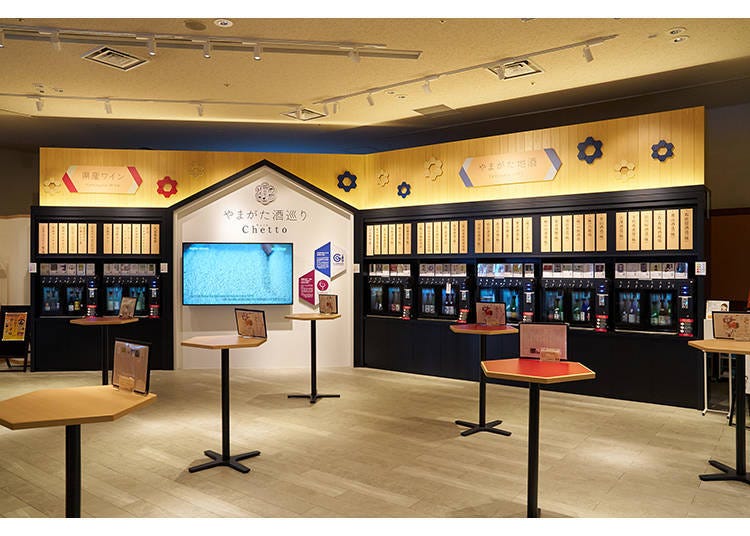
The name “Chotto” means “just a little” in the Yamagata dialect. True to its name, it’s a paradise for those who want to sample a variety of local sake and wine in small amounts. Buy three coins for 500 yen or six for 1,000 yen, grab a tasting cup at the counter, then simply insert a coin and press the button for the drink you’d like to try.
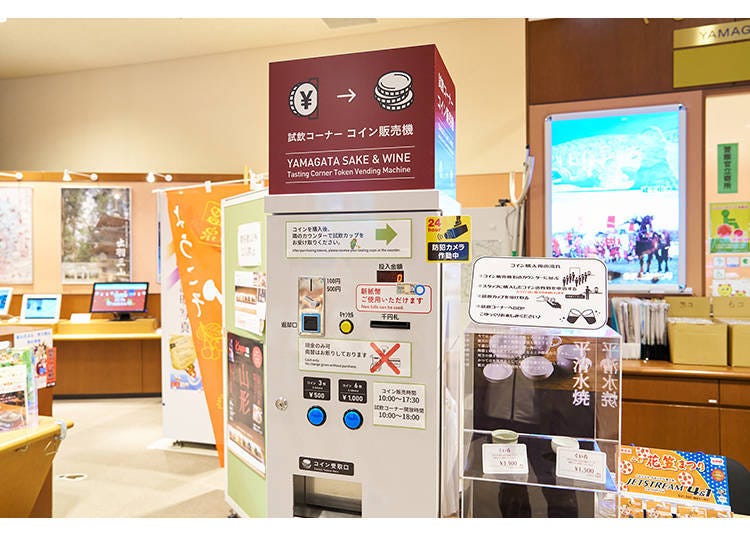
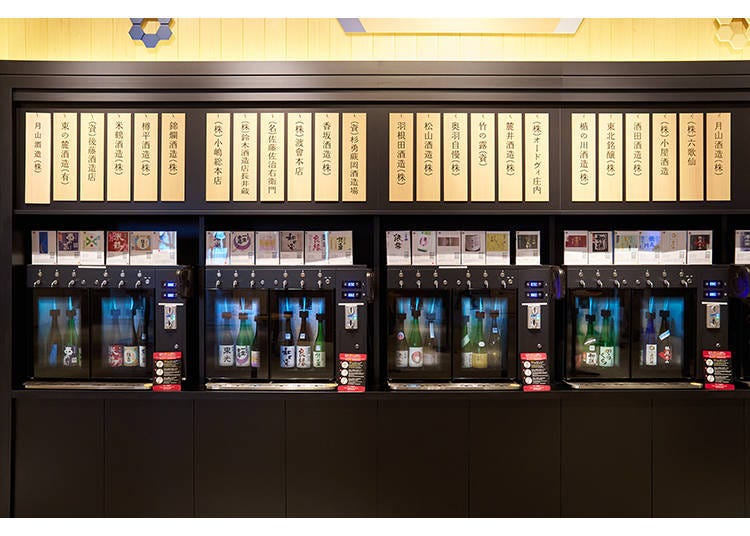
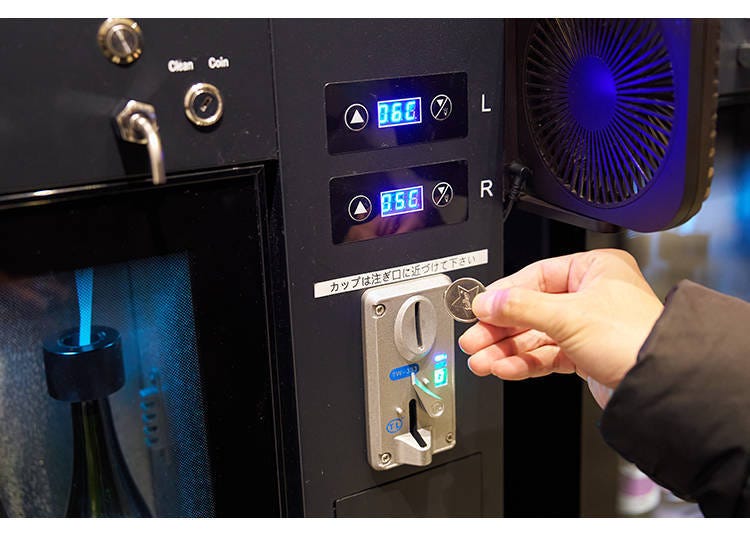
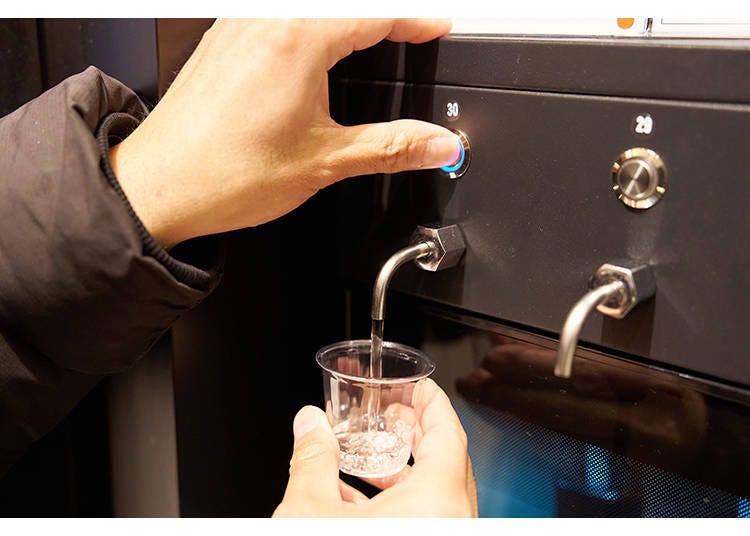
There are always 42 types of drinks to choose from. The selection includes six red wines and six white wines from local wineries. The lineup changes every month, and my boss even said, “I want to live here!” Yamagata has superb rice, a cold climate ideal for low‑temperature fermentation, and abundant brewing water from snowmelt—a natural blessing that makes it perfect for sake‑making.
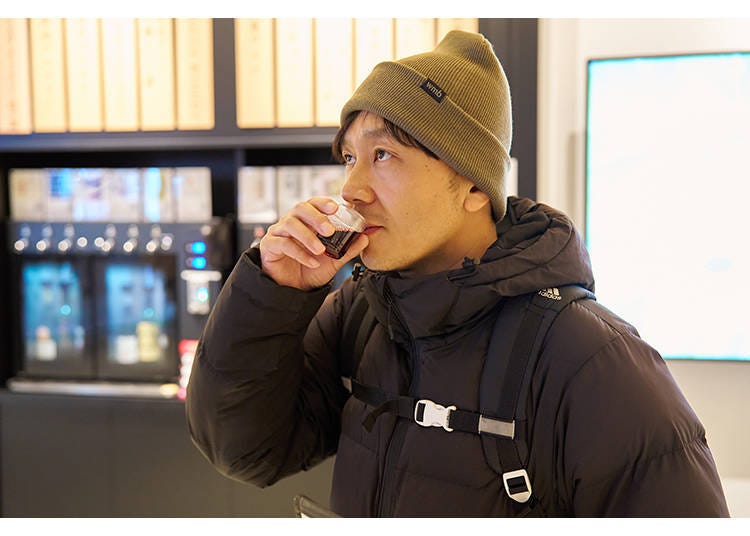
They introduced us to an unusual sake you’ll only find in Yamagata called “Yamagata Rikka” (Yamagata no Kaori). It’s a junmai daiginjo developed by the prefecture and the sake brewers’ association using the award‑winning sake rice “Yukimegami” and brewed entirely with ingredients from Yamagata. Only select breweries are allowed to produce it. Although the brand name and label remain the same each year, the rice and brewery can change, so you can look forward to a different taste every time. You can even enjoy this premium sake here for just one coin—it tasted like pure happiness!
-
Yamagata Sake Tour ChettOやまがた酒巡り Chetto
- Address 1F Kajō Central, 1-1-1 Jonan-cho, Yamagata City, Yamagata Prefecture
・Hours: 10 AM–6 PM (coin purchases until 5:30 PM)
・Closed: Open daily
Incidentally, Yamagata Sake Tour ChettO is located inside the Yamagata Tourist Information Center. This facility provides information and support for travelers exploring the prefecture, so be sure to stop by and gather tips for your trip.
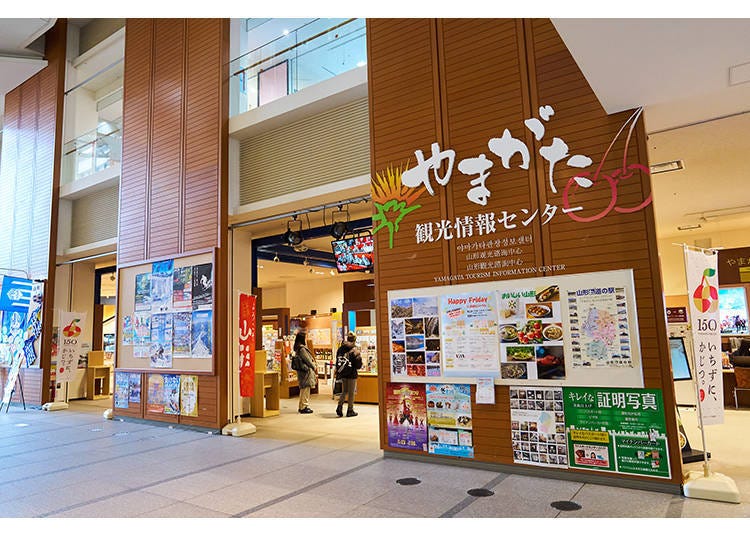
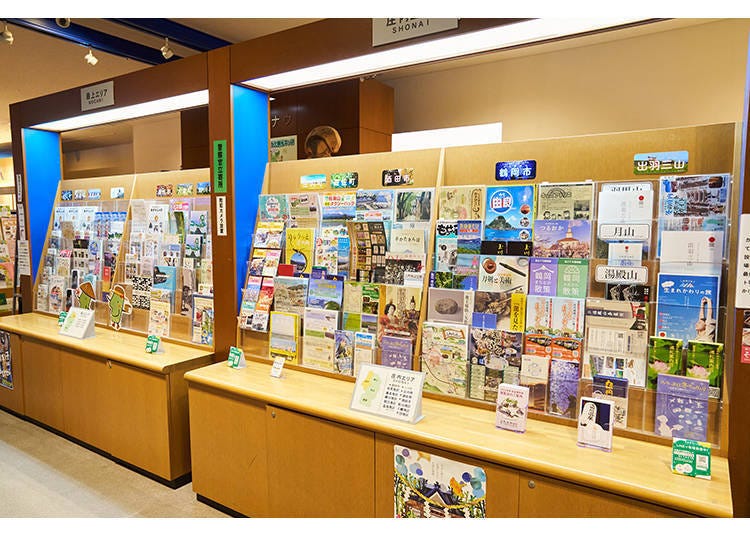
There are many more highlights to discover in Yamagata!
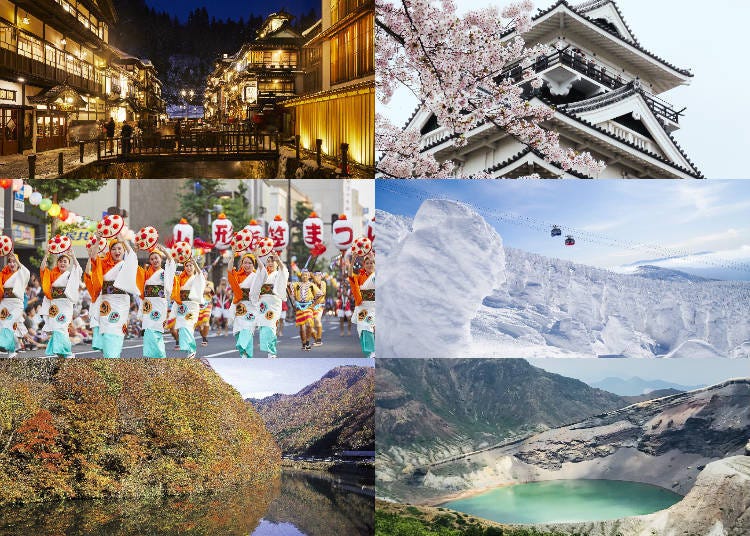
The area we traveled through was the Murayama region, home to Yamagata City and Zao. Yamagata Prefecture is vast and also includes the Mogami region centered on Shinjo, the Shonai region on the Sea of Japan side with Tsuruoka and Sakata, and the Okitama region around Yonezawa. There are many attractions we couldn’t cover this time. Famous sights include Ginzan Onsen, Zao’s volcanic Okama crater lake, the sacred Dewa Sanzan mountains, Kamo Aquarium, the Zao Echo Line, and the historic Sankyo Warehouses — and plenty more besides.
The LIVE JAPAN editorial team is a multinational group made up of native editors who have lived in Japan for over five years and Japanese editors who love to travel. Together, we share the best of Japan, offering cultural insights, historical context, event updates, and travel-friendly deals, to support your journey every step of the way.
- Area
- Category
*Prices and options mentioned are subject to change.
*Unless stated otherwise, all prices include tax.
Popular Tours & Activitiess
-

What to Buy in Aomori? 11 Aomori Souvenirs Locals Actually Recommend
by: ShiroKu inc.
-
Ad

Why Fukushima is the Next Big Food Destination in Japan The Foodie Paradise Only 90 Minutes from Tokyo
-

Aomori's Quiet Side in Autumn: 5 Scenic Spots in Hachinohe According to a Local
by: Marco Blasco
-
Ad

Advice from the Experts at Hitohira: Here's How to Choose the Best Japanese Knife
-

Shopping in Niigata: 9 Must-Buy Souvenirs & Local Sake to Take Home
by: ShiroKu inc.
-

Dining in Yamagata: Must-Try Foods & Top Restaurants Near the Station
by: ShiroKu inc.
-

Koiwai Farm Guide: Explore, Dine, and Play at Iwate's Top Agritourism Spot
-

Japan's Shinkansen Goes Half-Price!? JR East Launches "Osakini Tokudane Special (50% Off)"
-

What to Pack for Japan: 8 Essential Things for a Hassle-Free Trip
-

Your Trip to Sendai: The Complete Guide (Activities, Hotels, Savers & More)
-

The Ultimate Rail Journey? What Surprised An American About Japan's Shinkansen Bullet Trains
by: Fujico
-

Seafood Bowls and More at the Shiogama Seafood Wholesale Market!














